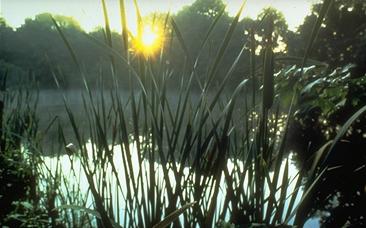Various Federal and State agencies have defined wetlands for the purposes of protection, conservation and management of the resource. All of these definitions stress the presence of specific conditions relating to the hydrology, soils and vegetation inherent to all wetlands.
 The U.S. Fish and Wildlife Service developed a scientifically-based definition used to accurately identify and delineate the Nation's wetlands for resource management purposes. This definition defines wetlands as follows:
The U.S. Fish and Wildlife Service developed a scientifically-based definition used to accurately identify and delineate the Nation's wetlands for resource management purposes. This definition defines wetlands as follows:
"Wetlands are lands transitional between terrestrial and aquatic systems where the water table is usually at or near the land surface or the land is covered by shallow water. For purposes of this classification wetlands must have one or more of the following three attributes: (1) at least periodically, the land supports predominantly hydrophytes; (2) the substrate is predominantly undrained hydric soil; and (3) the substrate is nonsoil and is saturated with water or covered by shallow water at some time during the growing season of each year." (Cowardin et al., 1979)
The U.S. Army Corps of Engineers (Corps) and the U.S. Environmental Protection Agency (EPA) define wetlands as follows:
 "Those areas that are inundated or saturated by surface or ground water at a frequency and duration sufficient to support, and that under normal circumstances do support, a prevalence of vegetation typically adapted for life in saturated soil conditions. Wetlands generally include swamps, marshes, bogs, and similar areas."
"Those areas that are inundated or saturated by surface or ground water at a frequency and duration sufficient to support, and that under normal circumstances do support, a prevalence of vegetation typically adapted for life in saturated soil conditions. Wetlands generally include swamps, marshes, bogs, and similar areas."
From the State of Maryland (Tidal Wetlands Act; Natural Resources Article, Annotated Code of Maryland Regulations)"Tidal wetlands" are defined as follows:
 "all State and private tidal wetlands, marshes, submerged aquatic vegetation, lands, and open water affected by the daily and periodic rise and fall of the tide within the Chesapeake Bay and its tributaries, the coastal bays adjacent to Maryland's coastal barrier islands, and the Atlantic Ocean to a distance of 3 miles offshore of the low water mark."
"all State and private tidal wetlands, marshes, submerged aquatic vegetation, lands, and open water affected by the daily and periodic rise and fall of the tide within the Chesapeake Bay and its tributaries, the coastal bays adjacent to Maryland's coastal barrier islands, and the Atlantic Ocean to a distance of 3 miles offshore of the low water mark."
"Private tidal wetlands" are defined as follows:
"Land not considered State wetland bordering on or lying beneath tidal waters, which is subject to regular or periodic tidal action and supports aquatic growth."
From the State of Maryland (Nontidal Wetlands Act; Natural Resources Article, Code of Maryland Regulations or COMAR) "Nontidal wetlands" are areas meeting the following conditions:
 "(a) ...an area that is inundated or saturated by surface water or ground water at a frequency and duration sufficient to support, and that under normal circumstances does support, a prevalence of vegetation typically adapted for life in staturated soil conditions, commonly known as hydrophytic vegetation;
"(a) ...an area that is inundated or saturated by surface water or ground water at a frequency and duration sufficient to support, and that under normal circumstances does support, a prevalence of vegetation typically adapted for life in staturated soil conditions, commonly known as hydrophytic vegetation;
(b) is determined according to the Federal Manual; (c) does not include tidal wetlands regulated under Natural Resources Article, Title 9, Annotated Code of Maryland."
COMAR defines the following specific types of wetlands: emergent, farmed, forested, isolated and scrub-shrub.
The State also recognizes nontidal wetlands containing "Significant plant or wildlife value -
-
Of the following unusual or unique community types:
-
(i) Bogs,
-
(ii) Areas with bald cypress, Atlantic white cedar, red spruce, balsam fir, or American larch that contain at least 20 percent of these species in any strata as determined by the Federal Manual, or
-
(iii) Delmarva Bays;
-
With water discharge that maintains minimum stream base flow important for maintaining plant and wildlife species;
-
With threatened or endangered species, or species in need of conservation;
-
Adjacent to Class III or Clas IV waters defind in COMAR 26.08.02.08;
-
Of Special State Concern;
-
Supporting vernal pools; or
-
That is regularly or periodically influenced by tidal waters."
Water Quality Standards are listed on the Maryland Office of the Secretary of State website in the Code of Maryland Regulations